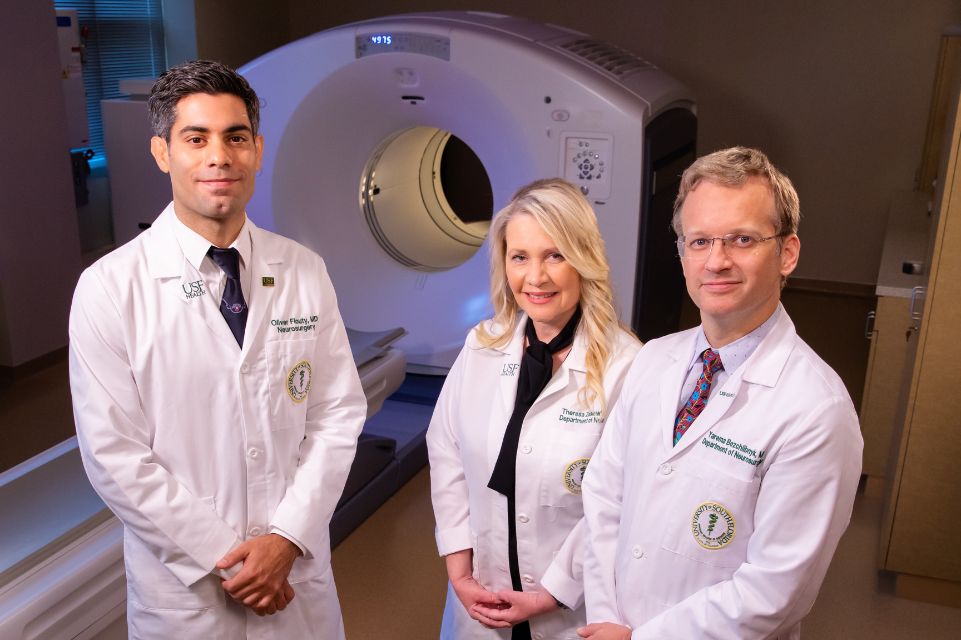Deep Brain Stimulation (DBS)
Deep brain stimulation is a therapeutic surgical option for treating symptoms of movement disorders, such as uncontrollable shaking, stiffness or slowness, associated with certain neurological conditions. These symptoms can result from disorganized electrical signals generated by areas of the brain that control movement. Functioning like a pacemaker for the brain, deep brain stimulation regulates the disorganized electrical signals by sending electrical impulses through electrodes implanted in these areas of the brain.
What Conditions Can Be Treated With Deep Brain Stimulation?
Deep brain stimulation may be a treatment option for a patient who is diagnosed with an advanced neurological condition that causes a movement disorder that cannot be adequately controlled with medication. Such conditions may include:
- Essential tremor
- Parkinson’s disease
- Dystonia
- Obsessive Compulsive Disorder
- Epilepsy
Recent studies suggest that some patients who are diagnosed with depression, obsessive-compulsive disorder (OCD) or Tourette’s symptom may also benefit from deep brain stimulation.
What are the Benefits of DBS?
Although deep brain stimulation does not cure movement disorders, it can significantly improve a patient’s quality of life. Additionally, the patient may require less medication — and experience fewer side effects — as a result. The device is custom programmed by a specialist to meet the specific needs of the patient, and can be adjusted over time.
Deep Brain Stimulation Procedure Details
Deep brain stimulation is usually completed during two separate surgical sessions spaced a few days or weeks apart to allow the patient sufficient time to recover. The process involves:
Stage 1 — During the first procedure, electrodes are implanted into specific areas of the brain. Guided by highly detailed MRI, the surgeon maps the brain and identifies the electrode placement sites. Depending on the area of the brain being targeted, the surgery may be performed with the patient asleep, using an MRI to guide placement of the leads, or the patient may be awake while the treatment team performs various tests to ensure the optimal placement of the electrodes. Typically, the patient remains in the hospital overnight for observation and is discharged the following day once cleared by the neurosurgeon.
Stage 2 — During the second procedure, a small pacemaker is implanted under the skin near the collarbone while the patient is asleep. The device is connected to the electrodes placed in stage 1 through thin, insulated extension wires passed under the skin of the neck. Typically, the patient may be discharged home the same day, when cleared by the neurosurgeon after the patient spends time in recovery. Follow-up appointments generally occur two weeks after stage 2 surgery for incision checks and four weeks after stage 1 surgery for activation and programming of the device. Routine appointments will be made to check the patient and device status.
An Effective Treatment for Movement Disorders at TGH

Tampa General Hospital (TGH) was one of the first sites in North America to offer deep brain stimulation and is currently among the busiest centers offering this therapy in the southeastern United States. TGH’s Movement Disorders Neuromodulation Center is a national referral center for the treatment of Parkinson’s disease, essential tremors and dystonia. In addition to a detailed neurological evaluation by the multidisciplinary team, success of surgery depends on precisely targeting specific areas of the brain with the deep brain stimulator leads and tailoring the delivery of the electrical stimulation to each patient’s specific symptoms. Equipped with a state-of-the-art intraoperative magnetic resonance imaging (MRI) surgical suite, our neurosurgeons have access to high-resolution, real-time images of the brain during and after procedures, allowing for an unprecedented level of precision and excellent outcomes. For those reasons and others, TGH ranks among the top 10% of hospitals in the United States for Neurology & Neurosurgery for 2025-26 by U.S. News & World Report.
TGH is committed to delivering the most recent advances in deep brain stimulation to our patients, including awake surgery with use of intraoperative neurophysiology and CT imaging, and asleep surgery using intraoperative MRI to confirm lead placement. Also, the neurosurgery team at TGH works with all three device manufacturers to offer devices with the latest cutting-edge technology, including directional leads and brain-sensing technology. With these advances, patients with Parkinson’s disease treated at TGH can expect an almost 70 percent improvement in symptoms due to tremors, stiffness and slowness leading to significant improvement in function and quality of life, and oftentimes a substantial reduction in Parkinson’s medications.
